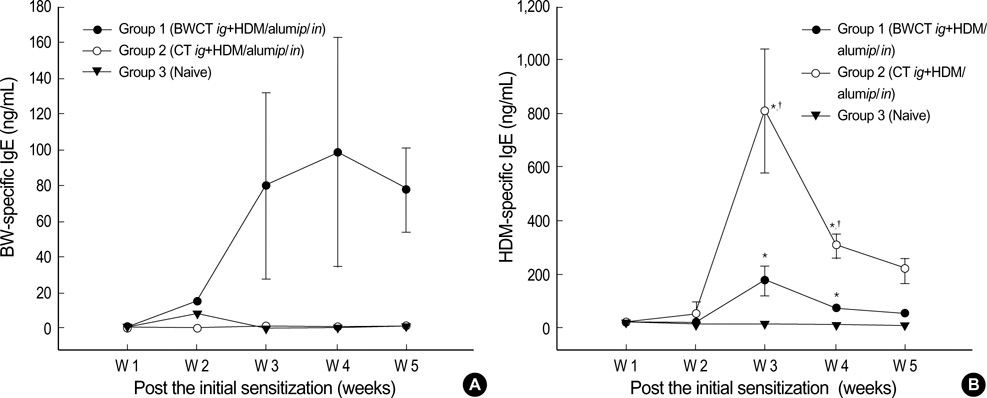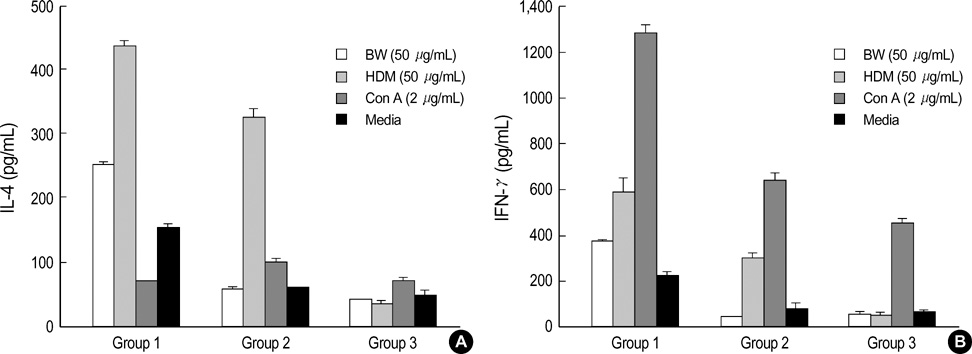J Korean Med Sci.
2007 Apr;22(2):198-204. 10.3346/jkms.2007.22.2.198.
Effect of Cosensitization with Buckwheat Flour Extract on the Production of House Dust Mite-specific IgE
- Affiliations
-
- 1Department of Pediatrics, Pochon CHA University College of Medicine, Seoul, Korea.
- 2Department of Pediatrics and Institute of Allergy, BK21 Project for Medical Science, Yonsei University College of Medicine, Seoul, Korea.
- 3Department of Pediatrics, Ajou University School of Medicine, San 5 Wonchon-dong, Youngtong-gu, Suwon, Korea. jsjs87@ajou.ac.kr
- 4Department of Parasitology, Yonsei University College of Medicine, Seoul, Korea.
- 5Department of Internal Medicine, Institute of Allergy, Yonsei University College of Medicine, Seoul, Korea.
- KMID: 1713160
- DOI: http://doi.org/10.3346/jkms.2007.22.2.198
Abstract
- There are studies reporting food sensitization in infancy increases the risk of sensitization to inhalants later in life. We performed a study to evaluate whether cosensitization with buckwheat (BW) has an effect on the production of house dust mite-IgE. C3H/HeJ mice (4 weeks, female) were sensitized with house dust mite (HDM)/Al (OH)3, intraperitoneally on day 0, followed by 4 intranasal sensitizations (on days 14, 15, 16, and 21). Group 1 was cosensitized intragastrically with BW/cholera toxin (CT) (on days 0, 1, 2, 7, and 18) during sensitization with HDM, group 2 was cosensitized intragastrically with CT only (on days 0, 1, 2, 7, and 18), and group 3 was used as controls. HDM- and BW-IgE and antigen-specific T-cell proliferation and cytokine production were evaluated. In Group 1, BW-IgE levels were highest at week 4, and the HDM-IgE at week 3 (98.45+/-64.37 ng/mL and 169.86+/-55.54 ng/mL, respectively). In Group 2, HDM-IgE levels reached a peak at week 3, remarkably higher (810.52+/-233.29 ng/mL) compared to those of Group 1 (169.86+/-55.54 ng/mL). The interleukin (IL)-4 and interferon (IFN)-gamma in the HDM-stimulated culture supernatants of splenocytes were not significantly different among groups. We postulate that the cosensitization with BW may down-regulate the specific IgE response to HDM.
MeSH Terms
Figure
Reference
-
1. Husby S, Mestecky J, Moldoveanu Z, Holland S, Elson CO. Oral tolerance in humans. T cell but not B cell tolerance after antigen feeding. J Immunol. 1994. 152:4663–4670.2. Husby S. Normal immune responses to ingested foods. J Pediatr Gastroenterol Nutr. 2000. 30:S13–S19.
Article3. Smith HL. Buckwheat-poisoning with report of a case in a man. Arch Int Med. 1909. 3:350–359.4. Platts-Mills TA, Thomas WR, Aalberse RC, Vervloet D, Champman MD. Dust mite allergens and asthma: report of a second international workshop. J Allergy Clin Immunol. 1992. 89:1046–1060.5. Hong CS. Sensitization of house dust mites in the allergic patients and mite ecology in their house dusts. J Asthma Allergy Clin Immunol. 1991. 11:457–465.6. Nickel R, Kulig M, Forster J, Bergmann R, Bauer CP, Lau S, Guggenmoos-Holzmann I, Wahn U. Sensitization to hen's egg at the age of twelve months is predictive for allergic sensitization to common indoor and outdoor allergens at the age of three years. J Allergy Clin Immunol. 1997. 99:613–617.
Article7. Peroni DG, Chatzimichail A, Boner AL. Food allergy: What can be done to prevent progression to asthma? Ann Allergy Asthma Immunol. 2002. 89:44–51.
Article8. Institute of Laboratory Animal Resources Commission on Life Sciences, National Research Council. Guide for the care and use of laboratory animals. 1996. Washington (DC): National Academy Press.9. Li XM, Serebrisky D, Lee SY, Huang CK, Bardina L, Schofield BH, Stanley JS, Burks AW, Bannon GA, Sampson HA. A murine model of peanut anaphylaxis: T and B cell responses to a major peanut allergen mimic human responses. J Allergy Clin Immunol. 2000. 106:150–158.10. Li XM, Schofield BH, Wang QF, Kim KH, Huang SK. Induction of pulmonary allergic responses by antigen-specific Th2 cells. J Immunol. 1998. 160:1378–1384.11. Li XM, Chopra RK, Chou TY, Schofield BH, Wills-Karp M, Huang SK. Mucosal IFN-gamma gene transfer inhibits pulmonary allergic responses in mice. J Immunol. 1996. 157:3216–3219.12. Nakamura T, Lee RK, Nam SY, Podack ER, Bottomly K, Flavell RA. Roles of IL-4 and IFN-gamma in stabilizing the T helper cell type 1 and 2 phenotype. J Immunol. 1997. 158:2648–2653.13. Sigurs N, Hattevig G, Kjellman B, Kjellman NI, Nilsson L, Bjorksten B. Appearance of atopic disease in relation to serum IgE antibodies in children followed up from birth for 4 to 15 years. J Allergy Clin Immunol. 1994. 94:757–763.
Article14. Zeiger RS, Heller S. The development and prediction of atopy in high-risk children: follow-up at age seven years in a prospective randomized study of combined maternal and infant food allergen avoidance. J Allergy Clin Immunol. 1995. 95:1179–1190.
Article15. Bruno G, Cantani A, Ragno V, Milita O, Ziruolo G, Businco L. Natural history of IgE antibodies in children at risk for atopy. Ann Allergy Asthma Immunol. 1995. 74:431–436.16. Strobel S. Neonatal oral tolerance. Ann N Y Acad Sci. 1996. 778:88–102.17. Li XM, Schofield BH, Huang CK, Kleiner GI, Sampson HA. A murine model of IgE-mediated cow's milk hypersensitivity. J Allergy Clin Immunol. 1999. 103:206–214.
Article18. Mowat AM. The regulation of the immune responses to dietary protein antigens. Immunol Today. 1987. 8:93–98.19. Lamont AG, Mowat AM, Parrott DM. Priming of systemic and local delayed-type hypersensitivity responses by feeding low doses of ovalbumin to mice. Immunology. 1989. 66:595–599.20. Martin TR, Galli SJ, Katona IM, Drazen JM. Role of mast cells in anaphylaxis. Evidence for the importance of mast cells in the cardiopulmonary alterations and death induced by anti-IgE in mice. J Clin Invest. 1989. 83:1375–1383.
Article21. Ishizaka T, Tomioka H, Ishizaka K. Degranulation of human basophil leukocytes by anti-gamma E antibody. J Immunol. 1971. 106:705–710.22. Sampson HA. Food Allergy. JAMA. 1997. 278:1888–1894.
Article23. von Garnier C, Astori M, Kettner A, Dufour N, Corradin G, Spertini F. In vivo kinetics of the immunoglobulin E response to allergen: bystander effect of coimmunization and relationship with anaphylaxis. Clin Exp Allergy. 2002. 32:401–410.
Article24. Kullberg MC, Pearce EJ, Hieny SE, Sher A, Berzofsky JA. Infection with Schistosoma mansoni alters Th1/Th2 cytokine responses to a non-parasite antigen. J Immunol. 1992. 148:3264–3270.25. Benjaponpitak S, Oro A, Maguire P, Marinkovich V, DeKruyff RH, Umetsu DT. The kinetics of change in cytokine production by CD4 T cells during conventional allergen immunotherapy. J Allergy Clin Immunol. 1999. 103:468–475.
Article26. Liu AH. Endotoxin exposure in allergy and asthma: reconciling a paradox. J Allergy Clin Immunol. 2002. 109:379–392.
Article27. Lee SY, Oh S, Lee K, Jang YJ, Sohn MH, Lee KE, Kim KE. Murine model of buckwheat allergy by intragastric sensitization with fresh buckwheat flour extract. J Korean Med Sci. 2005. 20:566–572.
Article
- Full Text Links
- Actions
-
Cited
- CITED
-
- Close
- Share
- Similar articles
-
- Dermatophagoides Farinae, an Important Allergenic Substance in Buckwheat-Husk Pillows
- The Effects of Nonspecific IgE and IgG Antibodies on Basophil Histamine Release mediated by Specific IgE Antibodies
- Local production of specific IgE antibody to house dust mite in nasal polyp tissues
- A Comparative Study on Allergenicity of Raw and Hypoallergenic Buckwheat flour
- Correlation of Appearance of Nasal Eosinophils with Levels of Total Eosinophil Counts, Total IgE, and House Dust Mite Specific IgE in Children with Symptoms of Rhinitis





